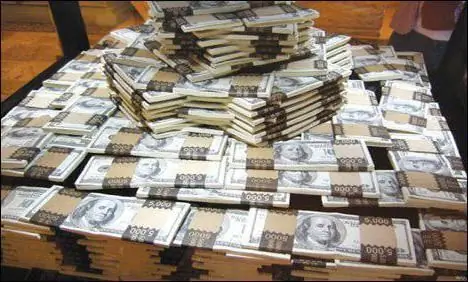2025 Author: Howard Calhoun | [email protected]. Last modified: 2025-01-24 13:10:25
The last of the aircraft factories built before the collapse of the USSR was the Ulyanovsk Aviation Plant. Designed for the production of huge An-124 aircraft and Tu-204 passenger liners, the enterprise can serve as a good illustration of what is happening in the industry.

A Brief History
The actual construction of the plant on the left bank of the Volga in Ulyanovsk began in 1976, and the first An-124 took off 9 years later. After another 5 years, the production of the Tu-204 was launched - this happened in August 1990, on the eve of a new period in the history of the country. Then something happened that, to a greater or lesser extent, was characteristic of the whole industry. Transformation into a joint-stock company in 1992, actual bankruptcy and separation from the aircraft production in order to save aircraft manufacturing facilities. So, in 1996, Aviastar-SP CJSC appeared. The abbreviation SP here means Aircraft Production. Somewhat later, the plant was transferred to the control loop"Tupolev", then (after the creation of the UAC) - in the UAC, the last place of subordination - the Directorate of Transport Aviation on the basis of PJSC Ilyushin.

What was and is being produced
The beginning of the work of the Ulyanovsk Aviation Plant was very spectacular. At its peak, the plant employed over 36,000 people. The vast majority of the Ruslans currently flying were assembled here. All Tu-204s of various modifications also left the gates of this enterprise. This serious backlog significantly helped the plant survive in difficult times, because all the cars produced needed maintenance and supplies of the necessary spare parts. In parallel with this, the production of reversing devices for the PS-90 engine was mastered. Much later, after the collapse of orders for the Tu-204 and An-124, the Ulyanovsk Aviation Plant "Aviastar-SP" switched to organizing the production of other aircraft. In particular, Il-76 MD-90A, a modification of the machine, previously produced in Tashkent. A contract was signed for the serial supply of 39 of these machines for the needs of the Ministry of Defense. Its cost is about 140 billion rubles.
At about the same time, the Ulyanovsk Aviation Plant, whose products were additionally replenished with fuselage panels and separate units for other machines, started installing interiors for SSJ aircraft. Attempts to organize the release of additional products were unsuccessful. In general, the Ulyanovsk Aviation Plant does not produce pots and other consumer goods. Based on the foregoing, one might get the impression that the plantprosperous and bathed in money. But not everything is as great as it is often reported and presented.

Problems
Today, about 10 thousand people work at the Ulyanovsk Aviation Plant. The enterprise has a solid social program, including the provision of housing for its employees and other benefits, by inertia stretching from the past. However, there is a huge "but". For many years, the plant has not mass-produced anything, that is, the aircraft are not handed over to customers. The result is an annual steady loss. To maintain the plant, and this is several billion rubles a year, loans are taken, advances are received, loans from parent organizations, and the output is almost nothing but individual units.
Deliveries of finished aircraft are piece, the territory is huge, the factory buildings amaze with their monumentality, the premises are being renovated, many people are involved in the factory management, they have their own fleet of cars, their own airfield and much more. The enterprise is one of the leaders in terms of the availability of modern machine tools. Therefore, there is a clear and blatant contradiction between the possibilities and the result.
People go to work every day, get paid twice a month, rooms are heated, open days are held, social programs are implemented, there are mentors and mentors, but there is no finished product. The main project of the plant, the already mentioned contract for 39 machines, is practically thwarted. In less than 7 years, only 5 cars were handed over to the customer, 3-5 more are planned fordelivery this year. Although there have been promises of this kind before. It is not surprising that today there are statements about the unprofitability of the contract and the allegedly low price. With the accumulation of costs for the maintenance of the plant over many years, not a single contract and not a single price of the final product is able to make a profit at such a rate of production.

Reasons
The main reason for this state of affairs is ignoring the changed scale of the market and its demands. In the USSR, all aircraft factories were built on a full cycle. And the Ulyanovsk Aviation Plant has many industries. That is, at the input of the plant - materials, at the output - finished aircraft. Factories occupy a gigantic area with corresponding overheads. The trouble is not so much in the “difficult legacy”, but in the fact that nothing has been done about this for two decades. There were many optimization plans, but they all remained on paper. The second reason is frame washout. There is a generational gap when very young employees and people of retirement age work in science-intensive industries. The middle generation is missing. Clearly not the worst qualified specialists left.
The situation now tends to improve, but the problem remains. All this is superimposed by the eternal misfortune called "paternalism", when everyone is waiting for something, because they believe that they are obliged to them. And all this completes - an endless series of building control loops and creating additional management mechanisms to influence production processes that go on as usual inat a very leisurely pace.
Recommended:
Conflicts in a team: ways to resolve them, classification, causes and effective methods for solving problems

The problem of conflicts in the team and ways to resolve them is relevant for people involved in various fields and areas. A specific feature of a person is the complexity of interaction with other persons under certain conditions. The larger the team, the higher the likelihood of conditions that are followed by tense conflict relations. Let's consider this topic in more detail
Reserves of banks and their formation. Required bank reserves and their norm

Bank reserves ensure the availability of funds for the uninterrupted fulfillment of payment obligations regarding the return of deposits to depositors and settlements with other financial institutions. In other words, they act as a guarantee
Bread defects: photos, causes, baking problems and how to fix them

Bread making is a complex technological process. Not surprisingly, finished bakery products can have various defects. They can be caused by the poor quality of raw materials, the mistakes of the baker who kneads the dough and bakes it. It is worth noting that the flaws associated with the quality of ingredients are extremely difficult to fix, while technological flaws can be corrected. The article tells about the defects of bread and how to eliminate them
Financial institutions, their types, goals, development, activities, problems. Financial institutions are

The financial system of any country has a key element - financial institutions. These are institutions that are engaged in the transfer of money, lending, investing, borrowing money, using various financial instruments for this
Why piglets grind their teeth: causes and treatment

Why do piglets grind their teeth? What exactly could cause such behavior and what to do about it? In fact, if young animals show obvious signs of illness, you should immediately contact your veterinarian. If the pigs are not lethargic, not painful and eat well, but periodically grind their teeth, then you need to watch them for a while

